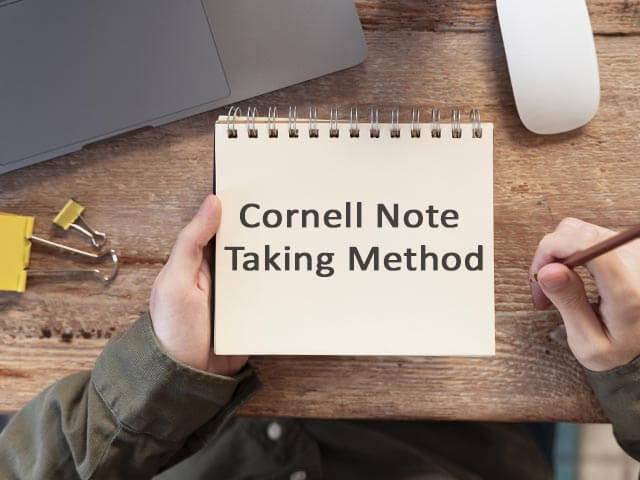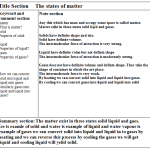Cornell Note-taking method
In University students are expected to make their own notes. There are many different methods of note-taking but the most famous and effective method is Cornell Note-taking. It was created by Prof.Walter Pauk of Cornell University in the 1950s. It is the most effective, easy way of organizing Textual information. This method of note-making was designed for college and university students. Prof.Walter Pauk explained the use of this method in his famous book titled “How to Study”.
Cornell Note-Taking Method

Parts of Cornell Notes:
The Cornell note-taking method consists of four parts.
- 1: Preparing your notepaper.
- 2: Taking notes.
- 3 Review and Expanding your notes.
- 4: Use your notes to study.
Part 1: Preparing your notepaper.
The first step is to divide the paper into four parts each part has a specific purpose.
- Title Section: This is the uppermost part of the page. It is used to write the title of the chapter. There is no rule for its dimension it should be large enough to write the title only.
- Notes section: It is on the right side of the page. It is the largest area of the note-taking paper. It width of its column should be a minimum of 6 inches.
- Keyword and comments section: It is on the left side of the page. The width of its column should be 2and1/2 inch. In this section, you can write keywords, comments, and questions to recall the information.
- Summary Section: This is the bottom part of your pages here you have to write 5 to 7 line summary of your notes
Part 2: Taking-notes
Points to remember while taking notes.
Write the title in the title section write the subject name and date in the corner this will help you to systematically arrange notes in chronological order.
Now write the important topic in the right section the note section of the paper. Write all important points in your own language you should write point-wise and by using short forms for example you want to write “if red litmus turns blue then the solution is acidic” you can write “it as R turns B the solution is Acidic” or simply R litmus B = A. You can use the same coded language and symbol which suites you.
You should draw small diagrams or charts using a pen you should draw a rough sketch during an ongoing lecture where it is necessary.
Write only bullet points, keywords, definitions, and generalized examples do not write illustrative examples keep notes as simple and as short as possible.
Start a new subtopic on a new page. Don’t use the same page for two different subtopics Give proper spacing between two words and lines to keep your note look neat and clean.
Make note of any question that came to your mind while listening to the lecture.
Keep some space empty on paper so that you can expand the note when you review it.
Part 3: Review and Expanding your notes.
Points to remember when you review and expand your notes.
Now you have to review your note for that keep your maker and reference book ready to highlight the keywords, definitions, and important lines with a marker pen.
Summarize your notes on-page in few lines at the bottom of the page in your own words. If you understand the topic well then you can easily write its’s scale-down summary in your own words. You can also use a short diagram, chart, mindmaps, formula, equations, etc if needed.
Read the notes understand it and frame a question that you think might appear in the exam on the current topic. Write this question in the left area of the note-taking page in the keyword and comment section area. You can also write keywords and your personal comment on the topic in this area of the page if you want.
Part 4: Use your note to study
Points to remember when you use your note to study.
Keep the right section of the page hidden by your hand or sheet of paper and read the question on the left side then go through The summary is written on the bottom of the page then try answering the question in your own words. Now remove the hand or paper sheet on the right side and judge your understanding and much information you are able to recall.
Review and Update your notes periodically. You may use a pencil to write notes initially and then use a pen when you review and expand it.
Cornell Notes Format
The typical format of the page for page according to Cornell note-taking method.

Conclusion:
This note-taking method makes the study more organized. Studies show that Cornell’s note-taking method is effective when it comes to the application of learned information.but it is not much effective when it comes to recalling the information. This method of taking-notes improve student logical reasoning and comprehension.
This method of note-taking is widely used by students in universities and colleges. It is widely used for subjects like biology and chemistry which requires logical thinking and deep comprehension. This method is very popular and used by not only college students but also by teachers who are pursuing Ph.D.
Cornell Notes Quiz
Ans: The Cornell note-taking method was invented by prof.Walter Pauk.
Ans: Prof.Walter Pauk invented this method while working at Cornell University in 1950. Hence it is called Cornell note-taking method.
Ans: Cornell note-taking method is use full for college and university students.
Ans: The page is divided into the four-part in this method. Title Section, keyword and comment section, note section, summary section.
Ans: The name of the book is “How to Study”.







